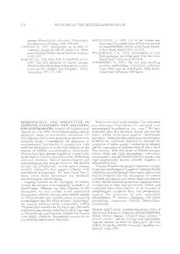
Morphology and molecules in lithistid taxonomy : new solutions for old problems PDF
Preview Morphology and molecules in lithistid taxonomy : new solutions for old problems
274 MEMOIRS OF THE QUEENSLAND MUSEUM sponge Rhopaloeides odorabile. Biochemical WHITELEGGE, T. 1889. List of the marine and Systematics and Ecology 15(5): 595-606. freshwaterinvertebratefaunaofPortJacksonand TOPSENT, E. 1897. Spongiaires de la Baie d' the neighbourhood. Journal ofthe Royal Society Amboine. Voyage de MM M. Bedot et C. Pictet ofNew South Wales23(2): 163-323. dansPArchipelMalais.RevueSuissedeZoologie WILKINSON, C.R. 1978. Description of two 4:421-487. Demospongiae, one being toxic from the Great WESCHE, S.J., ADLARD, R.D. & HOOPER, J.N.A. BarrierReef Tethys 8(3): 267-270. 1997. The first incidence of clionid sponges WOERHEIDE, G. 1997. The reef cave dwelling (Porifera)fromtheSydneyrockoysterSaccostrea coralline demosponge Astrosclera willeyana commercial-is (Iredale and Roughley, 1933). Lister 1900 from the Indo-Pacific. (PhD thesis, Aquaculture 157: 173-180. UniversitaatGottingen: Gottingen). MORPHOLOGY AND MOLECULES IN Whatistobedone inthissituation?Towhatextent LITHISTID TAXONOMY: NEW SOLUTIONS can molecular hypotheses be accepted over FOROLDPROBLEMS.MemoirsoftheQueensland morphological hypotheses or vice versa ? We have Museum44:274. 1999:-Mostlithistidspongeslackan found that rather than having to 'accept' one overthe adequate range of taxonomic characters for other, which often goes against 'instinctual differentiation, and inmostgenerathesecharactersare phylogeny', moleculardatamakesusre-examinethese extremely plastic. Consequently, the generation of problems by reciprocal illumination, through the morphological hypotheses in comparison with generation of higher quality morphological research molecularphytogenies is nearly impossible dueto the andtheexamination ofcharactersthatare often, notat absence of reliable synapomorphies. Historically, first, obvious. With this group of lithistid sponges, lithistids have been grouped together in a single order triaene rhabd and clade morphology, microsclere on the basis ofcommon possession ofan interlocking ornamentation,andthe patternsofdesmazygoses, and siliceous skeleton. Recent morphological and shaft ornamentation become crucially important in palaeontological data indicate, however, that lithistid differentiatingtaxa. sponges are polyphyletic; several genera possess Thus, forthisparticulargroupoforganisms,wehave skeletal characters that suggest affinity with found that morphological hypotheses between closely non-lithistid demosponges. We have found that in relatedtaxaareoftenstronglyinformativeandcanlend many cases these characters are probably crucial evidence for the acceptance of certain non-homologous and misleading. molecularphylogeniesoverothers. Moleculardatacan Ongoing research on the phylogeny of lithistid clearlyindicaterelationshipsbetweenorganismswhere sponges has revealed some interesting 'anomalies' of morphological data had previously failed, and identification. Although our data collection is still molecular data often require us to re-examine incomplete, we have already found unexpected morphological characters from new perspectives, phylogenetic affinities between three lithistid species leading the discovery of new taxonomic in Theonellidae and Corallistidae, comparing discriminators. O Porifera, phylogeny, 28S rDNA, morphological and 28S rDNA analyses. Surprisingly, morphology, congruence, lithistid, Theonellidae, the nearest relatives of de Laubenfel's (1954) Corallistidae. 'Plakinalopha'mirabilisare Theonellaspp.; Theonella atotlTahnetiocnaelislamosrppe.;claonsdelTyhreeolnaetledlatotCuobruallaltiastVeasnspSpo.estthains MMiccChoelrlmeaKcekl&ly*Ja(meemsaiOl.:Mmc.lkneelrlnye@ym,wZao.oaliojgvy:?)D,epaGrrtamceentP,. more closely related to Macandrewia azorica (in the Natural History Museum, Cromwell Road, London: * Corallistidae) thanto other Theonella. Present address: Marine Ec&ology and Aquaculture, National Institute of Water Atmospheric Research (NIWA),PrivateBag109-695, Newmarket,Auckland,New Zealand: 1June 1998.
